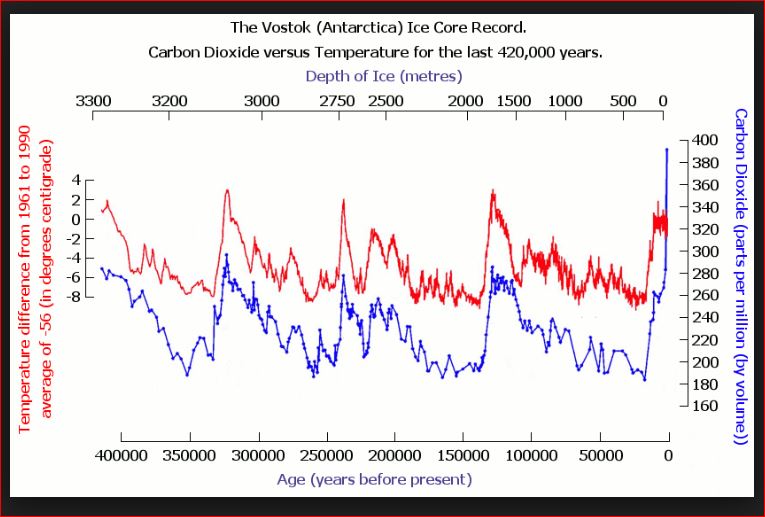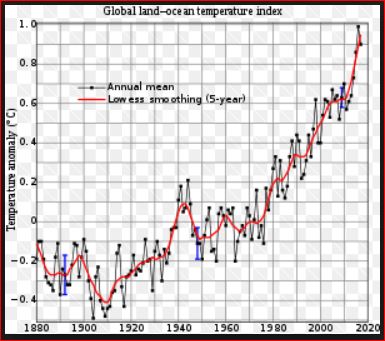Letter below was submitted to the Bernardsville News on 06-11-18. It was published in the on-line edition on 06-13-18 and in the print edition on 06-21-18.
I show two charts below the published letter and a comment.
Bill Allen 06-21-18
==============================================================
EDITOR:
There has been a spirited exchange of views in these pages regarding the current occupant of the Oval Office. A letter published on May 31 includes comments on global warming and related problems. I will respond and focus here on the science—not the politics—of this existential issue.
The writer accepts the fact that earth has warmed in recent years. He attributes this to “cycles of the sun” or “solar cycles.” I think he is referring to sun spot cycles. The number of spots that we see on the surface of the sun goes up and down over cycles of eleven years.
Earth receives more solar energy–what scientists call “insolation”–when there are more sun spots. This phenomenon can move earth temperatures up and down by small amounts over the 11-year cycles. But the warming that I worry about is over centuries. There is no evidence that sun spot cycles influence the long warming trend that we observe today.
Milutin Milankovic described three astronomical cycles in the 1920s, and suggested that they caused the ice ages. All numbers below are approximate.
- Earth moves around the sun in an elliptical orbit that widens and narrows over a cycle of 100,000 years.
- Earth rotates on an axis that is tilted with regard to the axis of its orbit, and this tilt moves back and forth by a small amount over a cycle of 41,000 years.
- The axis of earth rotation wobbles like a top over a cycle of 26,000 years.
Charts of temperature show saw-tooth patterns for the last four ice age cycles.
- The temperature cycles are 100,000 years long, like the orbital cycle. Let’s call these “long” cycles.
- Temperatures decline to a minimum over 90,000 years and then rise relatively rapidly by 10 degrees Celsius over 10,000 years.
- There are many smaller temperature ups and downs inside the long cycles.
The astronomical cycles change the amount of insolation that reaches the earth and its distribution over the earth’s surface, but not by enough to explain the rapid temperature rises in the long cycles.
Charts of atmospheric concentrations of carbon dioxide (CO2) show a strong correlation with the temperatures over the long cycles. All this leads to the theory that follows:
- During one part of the orbital cycle insolation increases, and this warms earth.
- Warming causes the release of CO2 from oceans, soils, and vegetation.
- This greenhouse gas rises into the atmosphere and causes more warming.
- There is a positive feedback loop: increased insolation warms the earth, which releases more greenhouse gas, which warms the earth, which releases more greenhouse gas, …
- Warming continues until later in the orbital cycle insolation decreases enough to stop warming and restart cooling.
Methane and other greenhouse gases influence temperature, but much less than CO2.
The letter writer states that CO2 levels have “drastically increased since the beginning of the industrial age,” that some of this has been absorbed by the ocean and caused an increase in acidity (lower pH), and that this “is a major global environmental concern …” I agree.
He does not mention that most of the increased CO2 has gone into the atmosphere where it contributes to global warming via the greenhouse effect.
Here are some things that scare me.
- Average CO2 concentrations during the last four long cycles swung between a low of 185 ppm (parts per million) and a high of 285 ppm. The rise during the warming phase was one part per million every 100 years.
- The current CO2 concentration of 410 ppm is 40% higher than the previous highs, and it is rising 200 times faster. There is no sign of slowing.
- We are in a phase of the orbital cycle when temperature should be falling. But temperature is rising at a rate ten times the rate at the end of the last long cycle.
- The natural cycle no longer controls. Man-made CO2 does.
- There is increasing evidence that CO2 and methane are being released from Arctic permafrost that is thawing. No one knows how these releases will grow or how to stop them.
The world we will leave to our children will be harder and more dangerous than the one we received. That’s certain.
Less certain is our will and ability to slow the warming process enough to allow future generations time to adjust to higher temperatures, and time to learn how to remove CO2 from the atmosphere and reverse the warming trend.
At stake is survival of the society we know.
Bill Allen 06-10-18
==============================================================
Two charts below were used to draft the letter above. I hope to comment further on them in the future.


Quote below is from new book Weather: an illustrated history: from cloud atlases to climate change co-authored by Andrew Revkin. He reported on the environment for many years for the NYT and then hosted an environmental blog for many more years.
“… our influence on the climate already guarantees tens of thousands of years of warmer conditions and rising sea levels (barring some geoengineering advance or an asteroid strike).”
